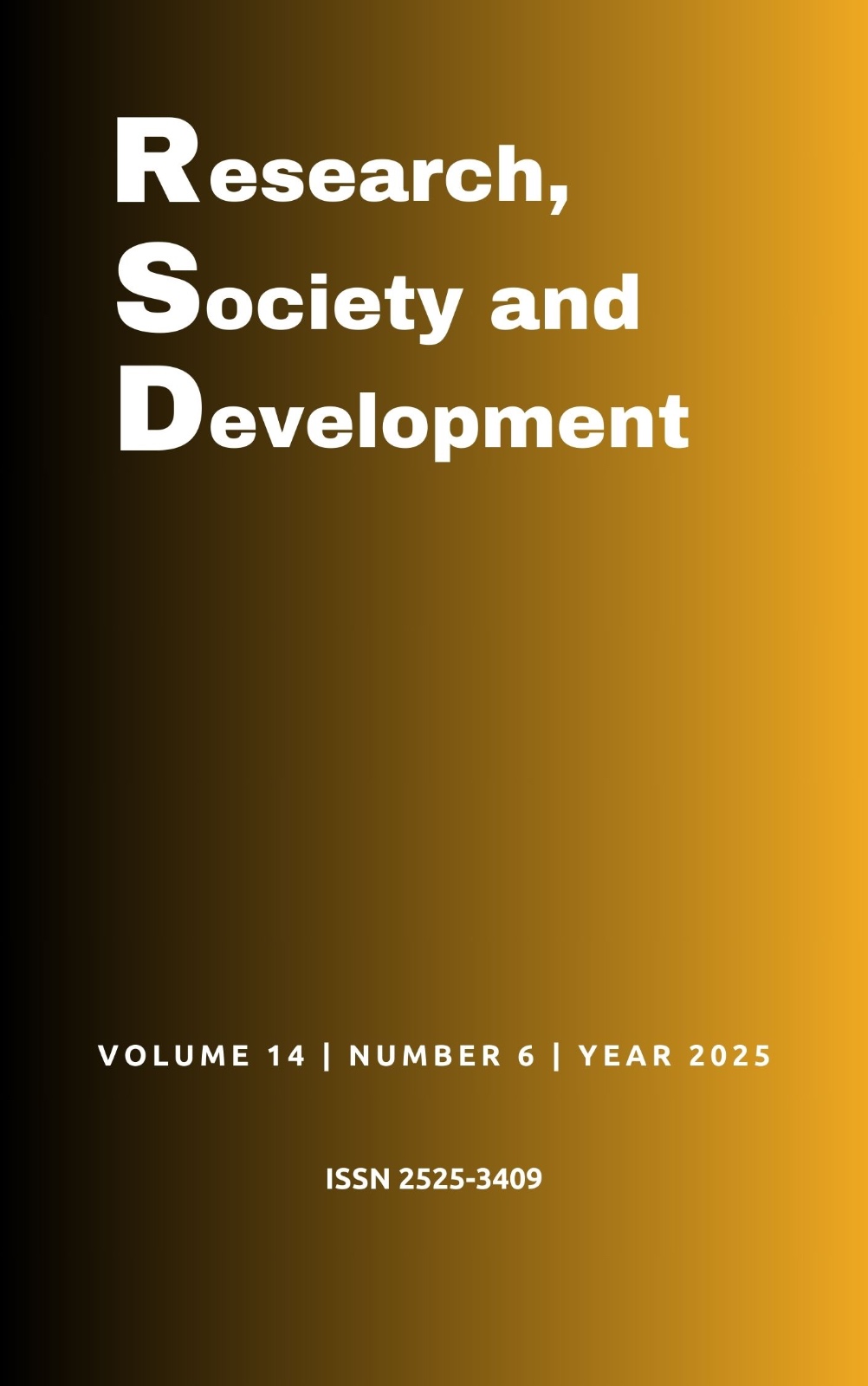Nodular formation in the spleen of a dog: Report of lymphoid nodular hyperplasia and discussion of the main differential diagnoses
DOI:
https://doi.org/10.33448/rsd-v14i6.48964Keywords:
Diagnostic approach, Splenectomy, Splenic lesions, Veterinary pathology.Abstract
Splenic nodular lesions in dogs pose significant diagnostic challenges, especially due to overlaps between benign and malignant processes. This report describes a case of splenic lymphoid nodular hyperplasia in an elderly mixed-breed dog, focusing on clinical, pathological, and therapeutic aspects. A descriptive study was conducted using clinical examinations, medical records, imaging, and histopathology. The patient presented with abdominal distension and spontaneous hemoperitoneum, which was attributed to a ruptured splenic hematoma. Splenectomy was performed, and histopathology revealed lymphoid hyperplasia with associated hemorrhage and necrosis, with no malignancy. Hematological findings included regenerative anemia, consumption thrombocytopenia, and neutrophilic leukocytosis. Biochemistry showed azotemia and mild liver enzyme elevation. Histopathological examination was key for definitive diagnosis, as imaging and cytology were inconclusive regarding the lesion’s nature. Surgical removal of the spleen led to clinical stabilization. It is concluded that, although benign, nodular lymphoid hyperplasia can result in severe clinical outcomes. Complete splenectomy and thorough histopathological analysis are essential for accurate diagnosis and appropriate treatment planning.
Downloads
References
Alessi, A. C., & Santos, R. L. (2023). Patologia veterinária (3ª ed., p. 590). Editora Roca.
Ballegeer, E. A., Forrest, L. J., Dickinson, R. M., Schutten, M. M., Delaney, F. A., & Young, K. M. (2007). Correlation of ultrasonographic appearance of lesions and cytologic and histologic diagnoses in splenic aspirates from dogs and cats: 32 cases (2002–2005). Journal of the American Veterinary Medical Association, 230(5), 690–696.
Bandinelli, M. B., Pavarini, S. P., Oliveira, E. C., Gomes, D. C., Cruz, C. E., & Driemeier, D. (2011). Estudo retrospectivo de lesões em baços de cães esplenectomizados: 179 casos. Pesquisa Veterinária Brasileira, 31, 697–701.
Barros, F. S., de Paula, E. G., Sueiro, F. A. R., & Jark, P. C. (2024). Caracterização histopatológica de lesões em baços de cães esplenectomizados. Ciência Animal, 34(4), 50–60.
Campos, A. G., Matera, J. M., & Campos, J. A. D. B. (2011). Esplenectomia em cães: estudo retrospectivo. Revista Acadêmica Ciência Animal, 9(3), 271–278.
Cesta, M. F. (2006). Normal structure, function, and histology of the spleen. Toxicologic Pathology, 34(5), 455–465.
Christensen, N., Canfield, P., Martin, P., Krockenberger, M., Spielman, D., & Bosward, K. (2009). Cytopathological and histopathological diagnosis of canine splenic disorders. Australian Veterinary Journal, 87(5), 175–181. https://doi.org/10.1111/j.1751-0813.2009.00421.x
Cole, P. A. (2012). Association of canine splenic hemangiosarcomas and hematomas with nodular lymphoid hyperplasia or siderotic nodules. Journal of Veterinary Diagnostic Investigation, 24(4), 759–762.
da Silva, J. G., Salzedas, B. A., & Xavier, J. G. (2024). Emprego da histopatologia no diagnóstico diferencial de lesões nodulares esplênicas em cães submetidos a esplenectomia. Revista Foco, 17(10), e6566.
De Mattos Junior, E., Russo, C., Santos, G. J. V. G., Balarin, M. R. S., & Saut, J. P. E. (2009). Avaliação da função hepática em cães submetidos a anestesia pela associação Zolazepam/Tiletamina. Semina: Ciências Agrárias, 30(2), 417–424.
De Souza, K. T. R., Herdy, M. A., Monteiro, L. M. V. W., & Knackfuss, F. B. (2020). Esplenectomia total em cão apresentando dois baços: Relato de caso. Pubvet, 14, 141.
Feldman, B. F., Zinkl, J. G., & Jain, N. C. (2000). Schalm's Veterinary Hematology (5ª ed.). Lippincott Williams & Wilkins.
Fry, M. M., & McGavin, M. D. (2007). Bone marrow, blood cells, and lymphatic system (pp. 743–832). In M. D. McGavin & J. F. Zachary (Eds.), Pathologic basis of veterinary disease (4th ed.). Mosby Elsevier.
Guedes, R. M. C., Zica, K. G. B., Coelho-Guedes, M. I. M., & Oliveira, S. R. (2000). Acurácia do exame citológico no diagnóstico de processos inflamatórios e proliferativos dos animais domésticos. Arquivo Brasileiro de Medicina Veterinária e Zootecnia, 52, 437–439.
Kaneko, J. J., Harvey, J. W., & Bruss, M. L. (1997). Clinical biochemistry of domestic animals (5th ed.). Academic Press.
McGavin, M. D., & Zachary, J. F. (2007). Pathologic basis of veterinary disease (4th ed.). Mosby Elsevier.
Meuten, D. J. (2017). Tumors in domestic animals (5th ed.). Wiley Blackwell.
Onkar, D. P., & Govardhan, S. A. (2017). Comparative histology of human and dog spleen. Journal of Morphological Sciences, 30(1), 0–0.
Patten, S. G., Boston, S. E., & Monteith, G. J. (2016). Outcome and prognostic factors for dogs with a histological diagnosis of splenic hematoma following splenectomy: 35 cases (2001–2013). The Canadian Veterinary Journal, 57(8), 842–846.
Pereira A. S. et al. (2018). Metodologia da pesquisa científica. [free e-book]. Editora UAB/NTE/UFSM.
Sabattini, S., Rigillo, A., Foiani, G., Marconato, L., Vascellari, M., Greco, A., Agnoli, C., Annoni, M., Melchiotti, E., Campigli, M., Benali, S. L., & Bettini, G. (2022). Clinicopathologic features and biologic behavior of canine splenic nodules with stromal, histiocytic and lymphoid components. Frontiers in Veterinary Science, 9, 962685. https://doi.org/10.3389/fvets.2022.962685
Toassi, R. F. C. & Petry, P. C. (2021). Metodologia científica aplicada à área da Saúde. (2ed). Editora da UFRGS.
Downloads
Published
Issue
Section
License
Copyright (c) 2025 Mariana Nogueira Machado; Guilherme Cabral Pinheiro; João Ricardo Sales Rocha Filgueiras; Caroline Gurgel Macambira; Rodrigo Fonseca de Medeiros Guedes; Belise Maria Oliveira Bezerra

This work is licensed under a Creative Commons Attribution 4.0 International License.
Authors who publish with this journal agree to the following terms:
1) Authors retain copyright and grant the journal right of first publication with the work simultaneously licensed under a Creative Commons Attribution License that allows others to share the work with an acknowledgement of the work's authorship and initial publication in this journal.
2) Authors are able to enter into separate, additional contractual arrangements for the non-exclusive distribution of the journal's published version of the work (e.g., post it to an institutional repository or publish it in a book), with an acknowledgement of its initial publication in this journal.
3) Authors are permitted and encouraged to post their work online (e.g., in institutional repositories or on their website) prior to and during the submission process, as it can lead to productive exchanges, as well as earlier and greater citation of published work.


